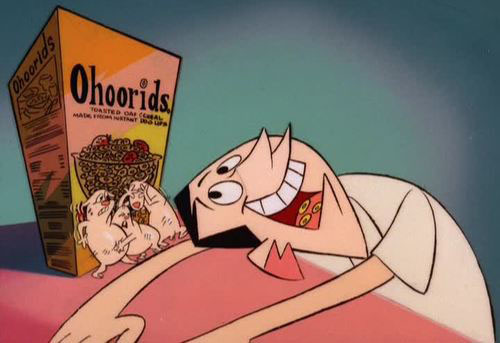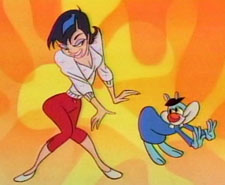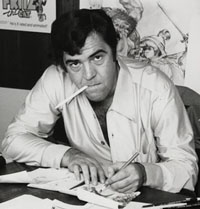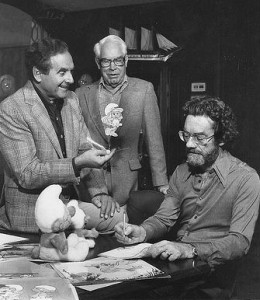
Mighty’s Benefit Plan. The episode Mighty’s Benefit Plan (Season 1, Episode 12 of Mighty Mouse: The New Adventures) featuring Elvy and the Tree Weasels (a parody of Alvin and the Chipmunks) is filled with hidden surprises.
Jim Reardon (later of The Simpsons, Wall-E and Wreck-It Ralph) wrote the script with John Kricfalusi but the initial idea came from animator Bob Jaques’ adventures working layout on The Chipmunk Adventure (1987). The caricature of a human girl dancing was Ralph Bakshi’s assistant Janelle Pranksy and designed by Lynne Naylor.
 The popular breakfast cereal, Cheerios, was featured in The Chipmunk Movie and was on cereal packages to promote the film. In the cartoon, the cereal is labeled “Ohoorids” (Oh! Horrid!) because when John Kricfalusi was working at a TV studio in Canada, the cereal boxes on kitchen sets had to be altered to avoid copyright and trademark problems and Cheerios became “Ohorrids”.
The popular breakfast cereal, Cheerios, was featured in The Chipmunk Movie and was on cereal packages to promote the film. In the cartoon, the cereal is labeled “Ohoorids” (Oh! Horrid!) because when John Kricfalusi was working at a TV studio in Canada, the cereal boxes on kitchen sets had to be altered to avoid copyright and trademark problems and Cheerios became “Ohorrids”.
Mashy the Pup was based on the actual dog belonging to the Bagdassarians. Janice Karman (Bagdassarin) loved her dog so much that the canine was caricatured as the evil Claudia’s pampered pooch in The Chipmunk Adventure. Sadly, the dog really was run over by a car midway through the production of the film.
“There were a couple of scenes that we wrote and actually animated that were too much for even Ralph (Bakshi), and he cut them out for fear that the network would come after us and kill us – this was 1987. I put them back in for retrospectives,” Kricfalusi told Martin “Dr. Toon” Goodman in September 2004.
 Bakshi Speaks About Animation Direction. Animator and director Ralph Bakshi in the November 1982 issue of American Premiere magazine talking about the recent release of his animated feature Hey Good Lookin’ said “I began working in animation because that’s where I got my first job as a director. And I stuck. I wanted to be able to have the same leverage that live-action directors have. I wanted to be able to treat many different subjects in animation. For some reason, that had never been tried in the medium. Some films worked and some didn’t, which proves that animation can be as fickle and as wonderful as live action.
Bakshi Speaks About Animation Direction. Animator and director Ralph Bakshi in the November 1982 issue of American Premiere magazine talking about the recent release of his animated feature Hey Good Lookin’ said “I began working in animation because that’s where I got my first job as a director. And I stuck. I wanted to be able to have the same leverage that live-action directors have. I wanted to be able to treat many different subjects in animation. For some reason, that had never been tried in the medium. Some films worked and some didn’t, which proves that animation can be as fickle and as wonderful as live action.
“I do not draw my movies. In directing animated films, the creative judgments – what to make and how to do it – don’t change from live-action films. Instead of hiring actors, I choose animators. Where a live-action director talks to his actors who give a performance, I talk to my animators who draw the characters. Art direction is much more severe in animation. I probably get much more involved in that than live-action directors. But I direct actors in a recording studio in order to get the correct attitudes in the voices of the characters. The problem of pacing, character development, story development, shooting and editing are the same in animation and live action.”
 Ken Harris and Richard Williams. Chuck Jones, interviewed in Business Screen magazine (Aug/Sept 1982) said, “Ken Harris was a brilliant comic animator, very unusual. His stuff would always be funnier than what I had described to him. He was a very kind and gentle person but he did broad animation. Richard Williams used him a lot, too. I think Dick Williams has a problem because he can’t make up his mind what he wants to be – whether he wants to be a director, an animator or a clean-up man. Yes, he even cleans up drawings! But I admire him tremendously. I think he should clarify his relationship to his projects. He should clearly be the director and not try to animate or clean up people’s drawings. Rather, he should try and provide whatever they need to allow them to clean up their own drawings.”
Ken Harris and Richard Williams. Chuck Jones, interviewed in Business Screen magazine (Aug/Sept 1982) said, “Ken Harris was a brilliant comic animator, very unusual. His stuff would always be funnier than what I had described to him. He was a very kind and gentle person but he did broad animation. Richard Williams used him a lot, too. I think Dick Williams has a problem because he can’t make up his mind what he wants to be – whether he wants to be a director, an animator or a clean-up man. Yes, he even cleans up drawings! But I admire him tremendously. I think he should clarify his relationship to his projects. He should clearly be the director and not try to animate or clean up people’s drawings. Rather, he should try and provide whatever they need to allow them to clean up their own drawings.”
 Katzenberg on Computer Animation. From the Boston Ledger newspaper Jan. 30-Feb 5, 1988, Jeffrey Katzenberg, then Chairman of the motion picture and television division of the Disney Company, said, “Computer animation will bring the cost down. It does take some of the process and make it much more efficient. Not the pure creative process of it. It really takes the process that is just labor intensive that just takes time. It is to give us a greater believablity without driving animators insane.
Katzenberg on Computer Animation. From the Boston Ledger newspaper Jan. 30-Feb 5, 1988, Jeffrey Katzenberg, then Chairman of the motion picture and television division of the Disney Company, said, “Computer animation will bring the cost down. It does take some of the process and make it much more efficient. Not the pure creative process of it. It really takes the process that is just labor intensive that just takes time. It is to give us a greater believablity without driving animators insane.
“It’s not likely computer animation will ever be the mainstay for characterization and it’s meant only to blend in with hand-drawn creations, not stand apart from them. However, it will undoubtedly be used more and more for inanimate objects or for filling colors or jobs of that ilk. It is a tool and it will be three to four years before computer animation is up to its full capabilities.”
 Penny on Pee-wee. From the Los Angeles Times June 29, 1988. Why were the clay animation “Penny” cartoons on Pee-wee’s Playhouse televsion series? “As I’m the host of the show and I’m a boy, I wanted to do a regular feature for girls that would be partially feminist in scope,” said producer-performer Paul Reubens.
Penny on Pee-wee. From the Los Angeles Times June 29, 1988. Why were the clay animation “Penny” cartoons on Pee-wee’s Playhouse televsion series? “As I’m the host of the show and I’m a boy, I wanted to do a regular feature for girls that would be partially feminist in scope,” said producer-performer Paul Reubens.
“We came up with the idea of having real little girls talk and then we edit and storyboard the results. I’m very pleased with that section because it’s totally a children’s piece. When Penny says things like ‘kids should have rights too’ it comes directly from a child’s perspective.”
Smurf Anvil. From the Wall Street Journal for December 23, 1982, Smurf creator Peyo (Pierre Culliford) was interviewed and said about the popular animated series: “The thing that most surprised me when working with Americans is the extraordinary degree of censorship they impose on their creations. I thought the U.S. was a country of complete freedom, but it isn’t true. Americans live in constant fear of what people will say and of minority groups.”
Peyo was not allowed to use nasty black Smurfs as he had in one of his published albums. “The Americans told me black Smurfs were out of the question but they liked the TV scenario so we had to turn them into purple Smurfs.” Smurfette couldn’t be the nagging little girl sent by Gargamel to sow discontent among the little people because it was considered sexist so she became “the Smurf’s friend” according to Peyo.
Having the moralizing Smurf get hit on the head with a croquet mallet had to be eliminated. “That couldn’t be shown on TV because the little spectator could very well go into his father’s garage, take a hammer and hit his kid sister on the head with it. I was told I could have the Smurf hit by an anvil because there’s less of a chance that a boy will find an anvil in his father’s garage.”




 Jim Korkis is an internationally respected animation historian who in recent years has devoted his attention to the many worlds of Disney. He was a columnist for a variety of animation magazines. With his former writing partner, John Cawley, he authored several animation related books including The Encyclopedia of Cartoon Superstars, How to Create Animation, Cartoon Confidential and Get Animated’s Animation Art Buyer’s Guide. He taught animation classes at the Disney Institute in Florida as well as instructing classes on acting and animation history for Disney Feature Animation: Florida.
Jim Korkis is an internationally respected animation historian who in recent years has devoted his attention to the many worlds of Disney. He was a columnist for a variety of animation magazines. With his former writing partner, John Cawley, he authored several animation related books including The Encyclopedia of Cartoon Superstars, How to Create Animation, Cartoon Confidential and Get Animated’s Animation Art Buyer’s Guide. He taught animation classes at the Disney Institute in Florida as well as instructing classes on acting and animation history for Disney Feature Animation: Florida.




















































That’s what I had noticed on The Smurfs episode The Purple Smurfs, that when the original version (The Black Smurfs) were to be animated there was a fear that there was going to be backlash by African American groups accusing Hanna Barbera and Peyo on having The Smurfs in a stereotype “Blackface” style.
So Hanna Barbera decided to change the color from black to purple – but, as stated above, this wasn’t the only change from the original comics. In The Astrosmurf, they changed the color of “The Swoofs” (the space creatures The Smurfs portrayed) from Orange to Green – and instead of clobbering Brainy Smurf with a mallet, the other smurfs chuck Brainy out of the Smurf Village and he lands on his head.
But a big one I’ve discovered is in the episode The Moor’s Baby – in which the Moor was reunited with his infant daughter and says “Thank the Gods” – instead of saying “Praise be to Allah” – the Moors were Muslim inhabitants of the Maghreb region of North Africa, descended from the Berber and Arab people of North Africa.
Smurfs are blue.:)
So Hanna Barbera decided to change the color from black to purple – but, as stated above, this wasn’t the only change from the original comics. In The Astrosmurf, they changed the color of “The Swoofs” (the space creatures The Smurfs portrayed) from Orange to Green – and instead of clobbering Brainy Smurf with a mallet, the other smurfs chuck Brainy out of the Smurf Village and he lands on his head.
That first season alone was a real doozy if you were already familiar with the comics by that point!
Interesting first hand account from Chuck Jones about Richard Williams; one master on another, and perhaps an interesting reason as to why the latter’s reported difficulties with schedule & budget with theatrical and TV projects.
I had the honour to meet Mr. Williams almost 10 years ago and actually found him very relaxed and open to others’ styles. During a Q & A a student assumed Mr. Williams would hate Family Guy. He actually said he liked it, but it was when he was talking about his personal projects that his fundamental adamant convictions came to the surface; that there are specific ways to do things in animation and that the hardest ways are the best, especially on his personal projects. Not that he ever would “mail it in”, but perhaps that’s why his success with advertisements in that there isn’t as deep personal attachment as to his bigger projects.
On a personal aside, in my modest experience, perfectionism takes the fun out of animation and today it is rampant, every level of production; supervisors, multiple directors, multiple producers and clients are doing what Jones said Williams was doing, except second-guessing themselves without the confidence,largely because the computer has created the illusion that it is easy to change things, so scenes go through hundreds of subjective needless revisions…on some baby show.
Give me the color-pops, the doping mistakes, the dust any day on something that is a million times more entertaining.
I remember really enjoying the rebooted Mighty Mouse, but could make it through less than five minutes of this. Oh, well …
Our memories of being 10 years old and seeing this pales in comparison to what we’ve seen by the time we’ve reached 40, but yeah, it’s the same for me too! This was certainly a show with “growing pains” as I put it. It was trying to dig out of the gutter Saturday morning was in and tried to navigate to a different place altogether, it hadn’t quite reached it yet, that had to wait a couple more years.
I forgot how brutal “Mighty’s Benefit Plan” is when it came to parodies, especially Mashy the Pup (goodness…..).
And I hate to sound like a network exec, but the mocking Ross & Janice’s dead dog was kinda petty and mean.
And I hate to sound like a network exec, but the mocking Ross & Janice’s dead dog was kinda petty and mean.
And yet it got me to stop liking Cherrios immediately, so I say that was a plus! The stories about Janice’s dog being a menace at that studio was far and wide!
Boy, I hadn’t seen “PEE-WEE’S PLAYHOUSE” in years, and I had totally forgotten about the PENNY cartoons. I thought the idea of animating around a child’s ramblings and thoughts was a fantastic idea, and it was little quirks like this that made the “PLAYHOUSE” episodes so memorable.
That and “El Hombre” (for our Latino set)!
I thought Mighty’s Benefit Plan was hilairious!
I suppose when you didn’t know the whole story behind the episode, it just works that way!